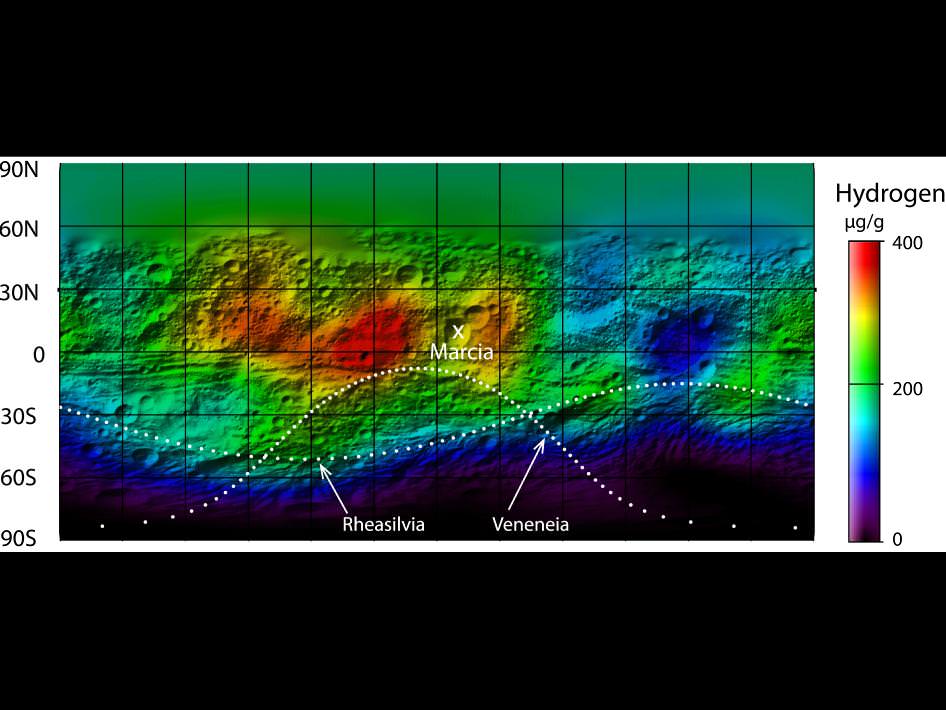This map from NASA’s Dawn mission shows the global distribution of hydrogen on the surface of the giant asteroid Vesta. Credit: NASA/JPL-Caltech/UCLA/PSI/MPS/DLR/IDA
The giant asteroid Vesta appears to have a bellyful of hydrogen. Data from the Dawn spacecraft reveals hydrated minerals in a wide area around Vesta’s equator. While Dawn did not find actual water ice, there are signs of hydrated minerals such as hydroxyl in the giant asteroid’s chemistry and geology.
“The source of the hydrogen within Vesta’s surface appears to be hydrated minerals delivered by carbon-rich space rocks that collided with Vesta at speeds slow enough to preserve their volatile content,” said Thomas Prettyman, lead scientist for Dawn’s gamma ray and neutron detector (GRaND) from the Planetary Science Institute.
A pitted terrain – looking much like potholes – mark where the volatiles, perhaps both hydroxyl and water, released from hydrated minerals boiled off.
Hydroxyl has recently been found on the Moon in permanently shadowed craters at the lunar poles, and so the Dawn scientists thought there might be a chance that water ice may have hunkered down near the surface around the giant asteroid’s poles, as well. But unlike Earth’s Moon, however, Vesta has no permanently shadowed polar regions, and so the strongest signature for hydrogen actually came from regions near the equator. And there, water ice is not stable.
Two papers were published this week in the journal Science that are based on observations from the low-altitude mapping orbit of the Dawn mission, an orbit which averaged about 210 km (130 miles) above the surface. Dawn left Vesta earlier this month, and is now on its way to its second target, the dwarf planet Ceres.
In addition to the paper authored by Prettyman and his team, a complementary paper, led by Brett Denevi, a Dawn participating scientist based at the Johns Hopkins University Applied Physics Laboratory describes the presence of pitted terrain created by the release of the volatiles.
In some cases, other space rocks crashed into these deposits later at high speed. The heat from the collisions converted the hydrogen bound to the minerals into water, which evaporated. The holes that were left as the water escaped stretch as much as 0.6 miles (1 kilometer) across and go down as deep as 700 feet (200 meters). Seen in images from Dawn’s framing camera, this pitted terrain is best preserved in sections of Marcia crater.
A distinctive “pitted terrain” observed by NASA’s Dawn mission on Vesta has also been seen on Mars. Credit: NASA/JPL-Caltech/University of Arizona/MPS/DLR/IDA/JHUAPL
“The pits look just like features seen on Mars, but while water was common on Mars, it was totally unexpected on Vesta in these high abundances,” said Denevi. “These results provide evidence that not only were hydrated materials present, but they played an important role in shaping the asteroid’s geology and the surface we see today.”
GRaND’s data are the first direct measurements describing the elemental composition of Vesta’s surface. Dawn’s elemental investigation by the instrument determined the ratios of iron to oxygen and iron to silicon in the surface materials. The new findings solidly confirm the connection between Vesta and a class of meteorites found on Earth called the Howardite, Eucrite and Diogenite meteorites, which have the same ratios for these elements. In addition, more volatile-rich fragments of other objects have been identified in these meteorites, which supports the idea that the volatile-rich material was deposited on Vesta.
Source: JPL



Fascinating!
“Dawn did not find actual water ice, there are signs of hydrated minerals such as hydroxyl in the giant asteroid’s chemistry and geology.” or “Hydroxyl has recently been found on the Moon…”
Wow. This is so surprisingly wrong. Do you know what “hydroxyl” is or actually means?
In chemistry, the hydroxyl in chemistry is known as the single negative charged radical, but it can also be neutral, I.e. “—OH”, that is present in many organic compounds but features prominently in the alcohols. I.e. Ethyl alcohol / ethanol, methanol, etc.
It is highly reactive but is not a “mineral” or “hydrated mineral”. It is usually a component of the mineral. (It says in the Press Release “likely in the form of hydroxyl or water bound to minerals in Vesta’s surface.” (Read “hydroxyl bound to minerals ” or “water bound to minerals”, NOT hydroxyl alone!!)
[An example of hydrated mineral is blue copper sulphate, which usually has five water molecules attached to it “.5H2O”. Most gems, I.e. rubies, emeralds, sapphire, etc. have water molecules attached.] Mixing hydroxyl would usual combine to form into water if isolated (or hydrogen peroxide.)
However, the hydroxyl molecule can exist as a gas in the near vacuum of space, and usually only appears in interstellar clouds at 18-cm wavelengths. Neural hydoxyl mostly exists at very low temperatures but is rare and short-lived at room temperature.
Well Done SJStar,
Beat me to it! Lets hope words like hydroxyl and used in a proper way in future.
Roseland Observatory.
I don’t think the intent was to say OH existed independently. I think most of the hydroxates were metal-OH, such as NaOH or Calcium hydroxide. LC
Gender has nothing to do with love!www.meetbi.com is a serious bisexual Social Site.